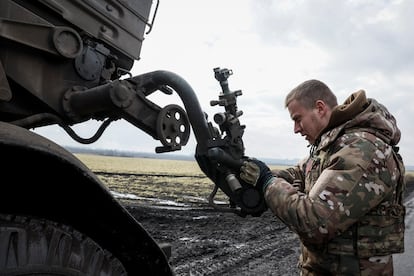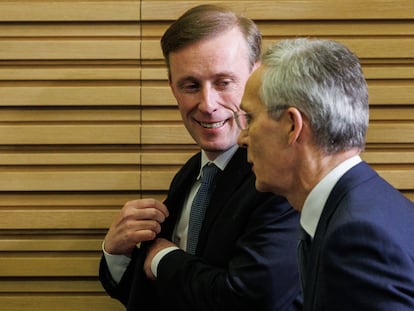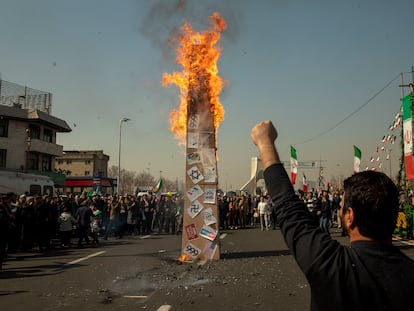NATO to set up training center to improve readiness of Ukrainian troops
According to the design being finalized by the Alliance, the new specialized center would provide more extensive training than is currently offered by the allies


NATO is to establish a training, analysis, and defense education center for Ukrainian troops. The new project, which will complement the EU training mission and programs that allies such as Spain already have in place, seeks to help Kyiv not only in the military preparation of its soldiers and personnel, but also to train them in the strategy and management of defense administration, according to allied sources. The aim is to raise the level of support for Ukraine and to help bring its forces up to NATO standards, with Kyiv hoping to one day join the Alliance.
Until now, NATO has avoided taking steps that Russia could interpret as a threat. For this reason, it is the members of the Alliance (bilaterally or in groups) who have provided Ukraine with military equipment and training. The new center represents a change of philosophy in this regard and a new element in the relationship between NATO and Kyiv. On the other hand, NATO allies have increased their defense spending to record levels this year, the organization announced Wednesday.
The 31 NATO allies are currently debating how the new center will be financed and what the role of instructors there will be: they could be based at the new center or come from personnel sent by NATO members for shorter periods, according to diplomatic sources familiar with the internal talks.
The Alliance’s defense ministers, who are meeting on Wednesday and Thursday in Brussels, will work out the details of the project, which is expected to receive final approval at the Washington summit in July. That will be a crucial date to commemorate the 75th anniversary of the Alliance and at which the new NATO secretary general may already be in place, replacing the Norwegian Jens Stoltenberg, who has served 10 years in the post through extended mandates. As of now, the only candidate on the table is acting Dutch Prime Minister Mark Rutte, who has broad support.

Country-by-country training
Several allied countries already have military training programs for Ukrainian soldiers. In Spain, training is mainly focused in Toledo, where training rotations of some 400 Ukrainian military personnel every two months are expected, according to data from the Spanish Ministry of Defense. The United Kingdom, Germany and Poland launched special preparedness projects months after the Russian invasion. Additionally, Denmark, with the support of Norway and the Netherlands, is centralizing pilot training for F-16 military fighters.
According to the design being finalized by NATO, the new specialized center would provide more extensive training than is currently offered by the allies. The military organization already has a curriculum for civilians working in Ukraine’s defense and security institutions. In July, at the Vilnius summit, the Alliance said it would invite Ukraine to join “when conditions permit.”
But Kyiv, at war, is not ready to join NATO, as Stoltenberg has pointed out. Not only because it is not in a position to “contribute to the security” of the Alliance for the duration of the conflict — it would also drag the allies into the war because of the mutual defense commitment — as stipulated in Article 10 of the Washington Treaty, but also because its armed forces and defense institutions do not meet NATO’s requirements. The new training program will “assist” Ukraine in the transition toward full interoperability with the organization, including its progress from Soviet-era doctrines, standards, and training, to those of the Alliance.
The idea of the training center under the NATO umbrella — for which Poland has offered to serve as a base — is a new step in support for Ukraine. It comes at a very difficult time for the invaded country, with the war launched by the Kremlin stalled and as the Alliance debates what role it will play in developing further support for Kyiv, while watching the possibility of Donald Trump’s return to the White House with trepidation. It is a discussion in which the Alliance is considering, for example, taking the lead in coordinating the so-called Ramstein group in support of Ukraine, within which some allies and non-member countries provide military hardware to Kyiv, and which is now led by the United States.
Record defense spending
Trump’s broadsides against NATO — toward which he has always been highly critical — and his insinuations over the weekend that he would not defend European allies that do not meet the minimum expenditure threshold from Russia have deeply unsettled the Alliance. Following Trump’s criticism, Stoltenberg said Wednesday that he expects 18 of the 31 members to reach the 2% of GDP in defense spending that was set as the benchmark at the Wales conference in 2014. That year, only three NATO members met that target. Since Russia invaded Ukraine in 2022, spending has risen across the board. By 2024, NATO allies in Europe will spend a combined total of $380 billion on defense, the alliance’s secretary general said.
Before the meeting with the defense ministers, Stoltenberg stressed that NATO is strong with the United States in it, but that NATO membership is also very important for Washington’s security. In addition, he again criticized Trump’s words. “Any suggestion that allies will not defend each other undermines all of our security, including that of the U.S., and puts American and European soldiers at increased risk,” he said. “We must leave no room for miscalculation or misunderstanding in Moscow about our readiness and our commitment, our resolve, to protect our allies. And the reason for doing so is not to provoke conflict, but to prevent it, as NATO has been successfully doing for 75 years.”
Sign up for our weekly newsletter to get more English-language news coverage from EL PAÍS USA Edition
Tu suscripción se está usando en otro dispositivo
¿Quieres añadir otro usuario a tu suscripción?
Si continúas leyendo en este dispositivo, no se podrá leer en el otro.
FlechaTu suscripción se está usando en otro dispositivo y solo puedes acceder a EL PAÍS desde un dispositivo a la vez.
Si quieres compartir tu cuenta, cambia tu suscripción a la modalidad Premium, así podrás añadir otro usuario. Cada uno accederá con su propia cuenta de email, lo que os permitirá personalizar vuestra experiencia en EL PAÍS.
¿Tienes una suscripción de empresa? Accede aquí para contratar más cuentas.
En el caso de no saber quién está usando tu cuenta, te recomendamos cambiar tu contraseña aquí.
Si decides continuar compartiendo tu cuenta, este mensaje se mostrará en tu dispositivo y en el de la otra persona que está usando tu cuenta de forma indefinida, afectando a tu experiencia de lectura. Puedes consultar aquí los términos y condiciones de la suscripción digital.
More information
Archived In
Últimas noticias
Trump claims peace in Ukraine is near, but Moscow suggests otherwise
A survivor’s account of the Interoceanic Train accident: ‘We were scared because of the speed on the curve’
The Interoceanic Train, the Mexican alternative to the Panama Canal
What is known about the Interoceanic Train derailment in Oaxaca
Most viewed
- Oona Chaplin: ‘I told James Cameron that I was living in a treehouse and starting a permaculture project with a friend’
- Reinhard Genzel, Nobel laureate in physics: ‘One-minute videos will never give you the truth’
- Why the price of coffee has skyrocketed: from Brazilian plantations to specialty coffee houses
- Pablo Escobar’s hippos: A serious environmental problem, 40 years on
- Chevy Chase, the beloved comedian who was a monster off camera: ‘Not everyone hated him, just the people who’ve worked with him’










































